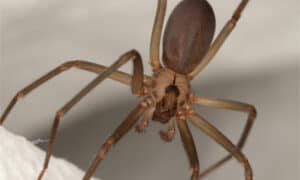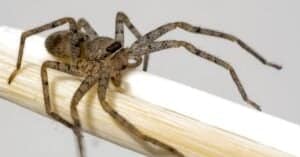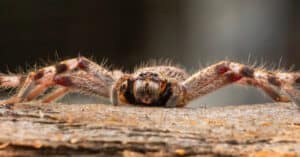The state of Utah is a great mix of unique cultures, gorgeous natural formations like the Great Salt Lake, and its rich national park program. Although it’s a great place to soak in the wonders of the natural world, it is home to some of the largest and most dangerous spiders in the U.S. We’re going to turn our attention to the former and look at five of the biggest spiders in Utah. We’ll tell you which ones you need to watch out for, and which ones are large and harmless.
What Are the Biggest Spiders in Utah?
The spiders that inhabit Utah vary in size and potential for danger to humans. Although one of the biggest spiders in Utah is the desert tarantula, a creature that is a combination of both large and dangerous, not all of the biggest spiders are the worst ones. Let’s explore the five largest spiders and see how big they get, where they’re found, and how they can harm a person.
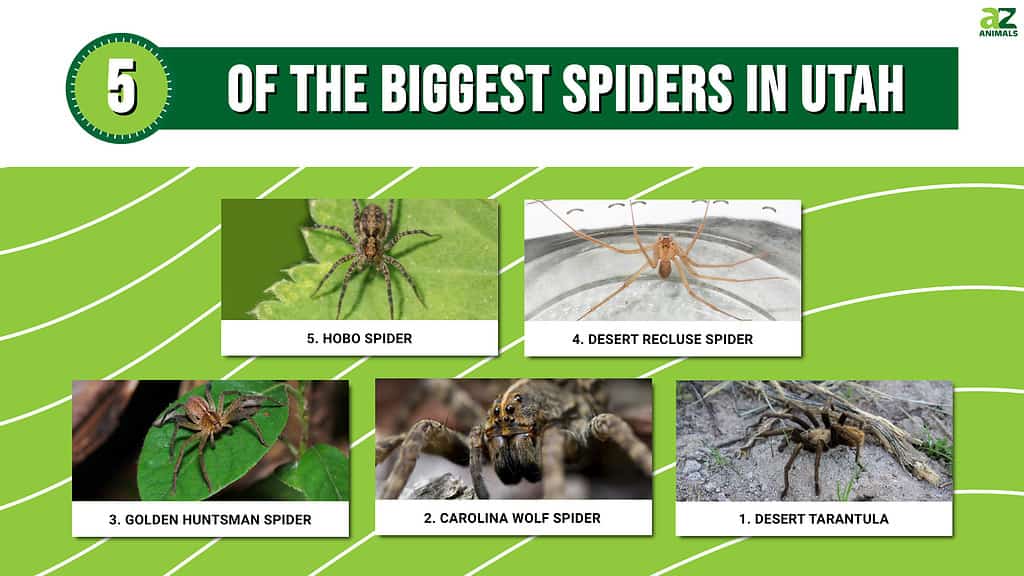
5. Hobo Spider

Hobo spiders reach 1 ro 2 inches and are found in grassy fields
©SNEHIT PHOTO/Shutterstock.com
| Scientific Name | Size | Danger to Humans |
|---|---|---|
| Eratigena agrestis | 1-2 inches | A bite can cause moderate pain and some redness at the site, but they’re not deadly. |
The hobo spider had a reputation for being dangerous to people in the past. However, that belief was mistaken, and it turns out that hobo spiders cannot cause the necrotizing bites that made people fear them for years.
These spiders are often found in grassy fields with tall vegetation and the outside of man-made structures where they can spin their funnel-like webs in cracks and crevices. Since these spiders are roughly the same size and color as a brown recluse, they’re often confused for one another.
However, the hobo spider has a thicker abdomen, lacks the violin pattern on its cephalothorax, and has patterns on its abdomen. Make no mistake, these spiders can bite humans. However, they only cause some pain and redness rather than a large wound.
4. Desert Recluse Spider
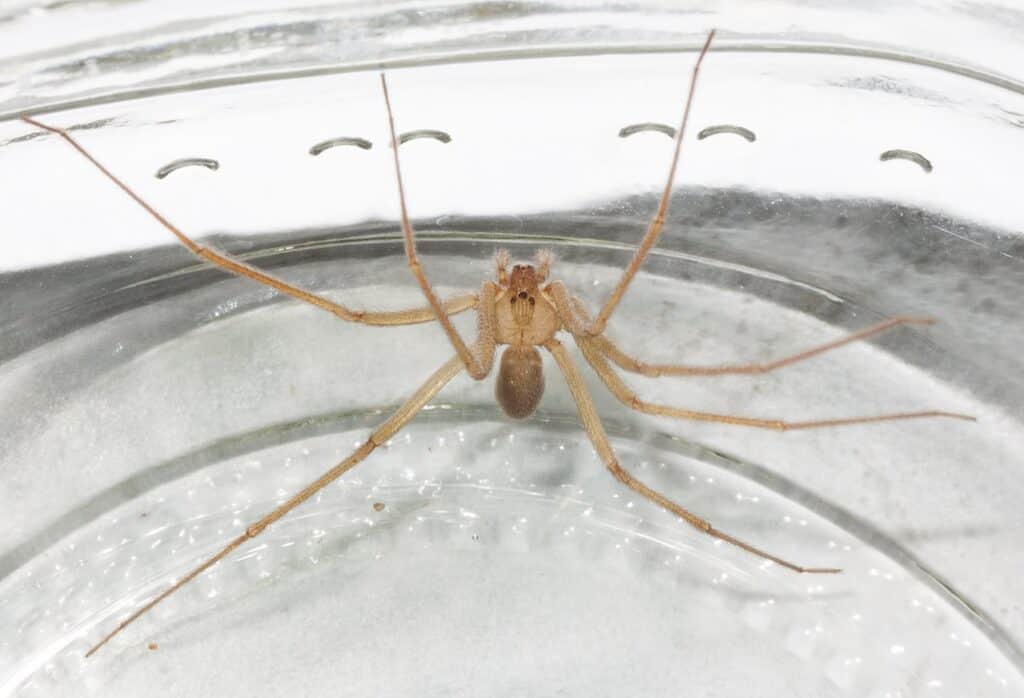
Desert recluse spiders have a 2 inch legspan and a short body
©DesertTrip / CC BY-SA 4.0, via Wikimedia Commons – License
| Scientific Name | Size | Danger to Humans |
|---|---|---|
| Loxosceles deserta | 1.5-2 inches | Inflicts a painful necrotic bite that causes severe damage to the afflicted area and may require medical aid. |
The desert recluse is a spider with a legspan that measures up to 2 inches long despite having a relatively short body. They are also easily confused for the brown recluse as well as the hobo spider. The desert recluse is a brown spider with a violin-shaped marking on the cephalothorax and long legs.
They are usually found nesting outdoors in tall vegetation where they’ll be left alone or in rat dens. They rarely go near homes unless there is some type of native vegetation in the area. Although they are not very large or common near homes, they can be troublesome.
The bite of a desert recluse can create a painful lesion on the body that takes weeks to heal. In the meantime, this open wound will be prone to infections. It’s best to seek medical attention to get proper aid in overcoming this bite.
3. Golden Huntsman Spider
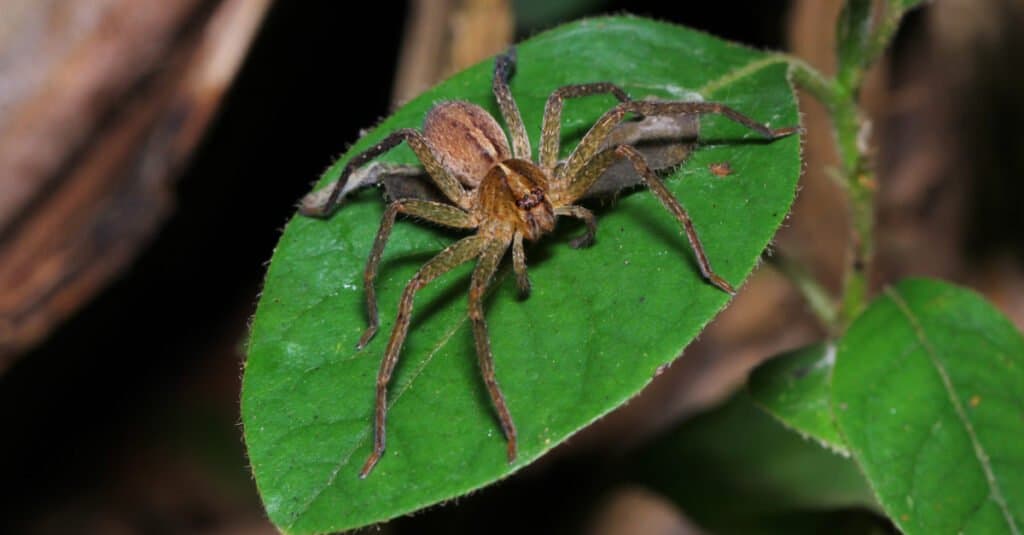
Golden huntsman spiders live in forests and woodpiles where they are unlikely to be disturbed
©Pong Wira/Shutterstock.com
| Scientific Name | Size | Danger to Humans |
|---|---|---|
| Olios giganteus | 1.5-3inches | May cause a seriously painful bite, and foreign species can cause serious health complications. |
The golden huntsman spider is a member of the Sparassidae family, and it’s sometimes called the giant crab spider for its unusual shape. They’re fond of places with wood like forests, piles of chopped wood, and even wooden homes. They live in places that are not often disturbed by humans.
These spiders have a golden brown, brown, tan, and even orange color with a dark mark running the length of their abdomen. Their legs are often light brown and black near the ends. The orientation of their legs and tarsals gives them the appearance of a crab, hence their secondary common name.
Also, they do not like when people disturb the area that contains their eggs. If you disturb their nest or handle them, the golden huntsman spider can bite you. Their bite is not medically significant in most cases. However, a huntsman spider bite can be very painful, and some species can cause health complications. Thus, it’s important to leave this spider alone.
2. Carolina Wolf Spider
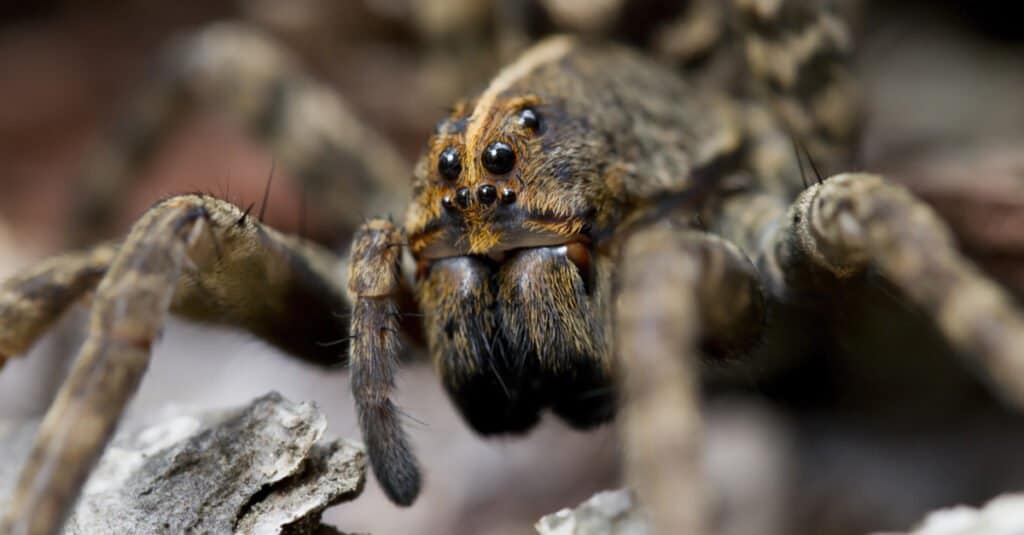
The Carolina wolf spider has a 4 inch legspan and a large body
©Will E. Davis/Shutterstock.com
| Scientific Name | Size | Danger to Humans |
|---|---|---|
| Hogna carolinensis | 2-4 inches | The bite from this spider causes local pain and swelling that can get worse if the person is allergic. |
The Carolina wolf spider is one of the biggest spiders in Utah as well as the largest in its family in the United States. This spider can grow upwards of four inches long including its legspan with a body that is over an inch and a half long.
These spiders can appear in a variety of colors including black, gray, white, and tan. Typically, their bodies will be a brown or light brown color with a light medial stripe on the carapace with two dark marks on either side. Their abdomen will have a dark cardiac mark surrounded by light-colored stripes.
Wolf spider bites are painful because they are so large. Yet, bites from them are also rare. These spiders have to be coaxed to bite people in most cases. If you get bitten by this spider, you’ll feel some moderate pain and experience swelling and itching in the area.
People who are allergic to their venom may experience cramps, rashes, sweating, and difficulty breathing. If those symptoms are present, the individual must see a doctor immediately.
1. Desert Tarantula
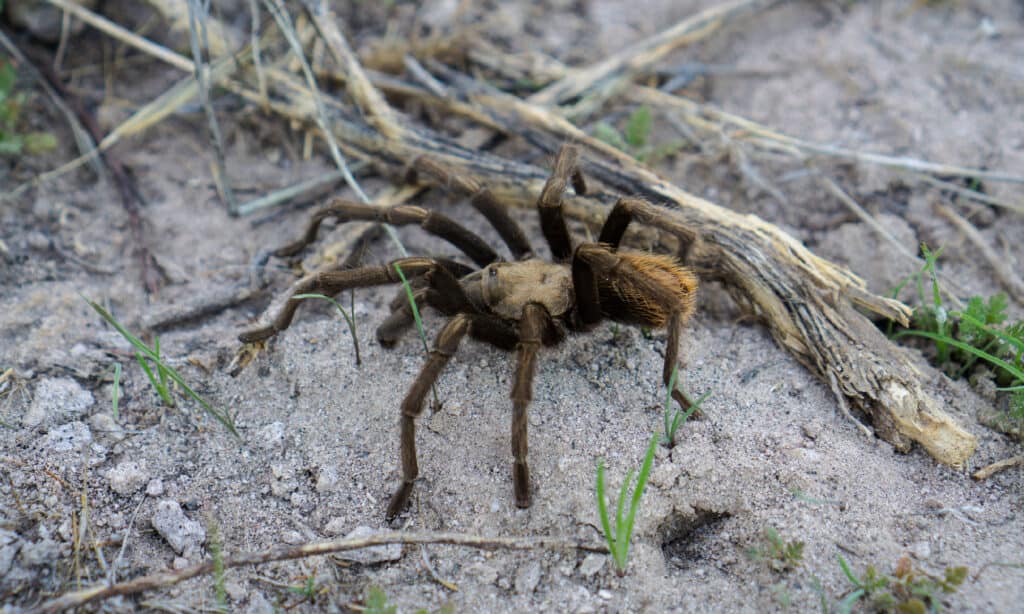
Desert tarantulas have large hairy bodies and a leg span of approximately 5 inches
©iStock.com/Stephen Couch
| Scientific Name | Size | Danger to Humans |
|---|---|---|
| Aphonopelma Iodius | 4 to 5.5 inches | Delivers a painful bite that will cause swelling, redness, and itchiness and leave puncture wounds. May require medical assistance. |
The biggest spider in Utah is the desert tarantula which also happens to have one of the most significant bites. A desert tarantula can measure over 5.5 inches in length, and they have very large fangs for spiders. As a result, their bite will cause moderate to severe pain, swelling, redness, and itchiness.
The resulting puncture wounds must be watched for signs of infection too. It’s a good idea to seek medical consultations for any confirmed tarantula bite just to be safe.
Females are usually tan all over, but males have a reddish-brown cephalothorax, reddish hairs on their brown abdomen, and black legs. They often dig burrows that they use to help keep them hidden while they wait for prey to come by. These spiders are large, venomous, and highly effective hunters.
We’ve seen some large and dangerous spiders on the list of the biggest spiders in Utah. However, we haven’t named the most dangerous spider in Utah, and that is the black widow. This spider can cause serious health effects and even death in rare cases.
Also, the brown recluse is rarely seen in Utah, but it should be avoided since it has the potential to cause harm. Learn to recognize each of these spiders so you can avoid any health problems associated with a bite.
Summary of 5 of the Biggest Spiders in Utah
| Rank | Spider |
|---|---|
| 1 | Desert Tarantula |
| 2 | Carolina Wolf Spider |
| 3 | Golden Huntsman Spider |
| 4 | Desert Recluse Spider |
| 5 | Hobo Spider |
The photo featured at the top of this post is © Brett Hondow/Shutterstock.com
Sources
- Web MD, Available here: https://www.webmd.com/a-to-z-guides/what-you-need-to-know-about-a-wolf-spider-bite#:~:text=%E2%80%8CWolf%20spiders%20don't%20pose,it%20shouldn't%20last%20long.
- Utah State University, Available here: https://extension.usu.edu/pests/schoolipm/structural-pest-id-guide/desert-recluse-spider
- Insect Identification, Available here: https://www.insectidentification.org/insect-description.php?identification=Desert-Tarantula#:~:text=It%20should%20be%20noted%20that,may%20result%20in%20sensitive%20individuals
- Natural History Museum of Utah, Available here: https://nhmu.utah.edu/blog/2016/10/10/humanity-arachnids-carolina-wolf-spider-story#:~:text=Some%20more%20facts%20about%20Carolina,in%20burrows%20that%20they%20create
Thank you for reading! Have some feedback for us? Contact the AZ Animals editorial team.



